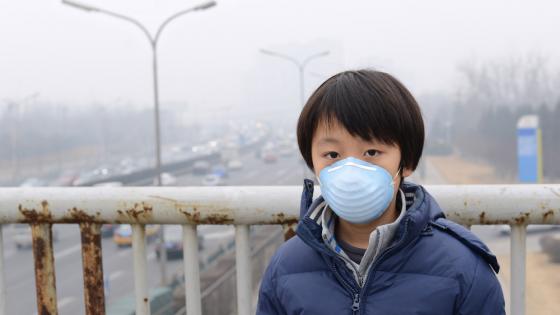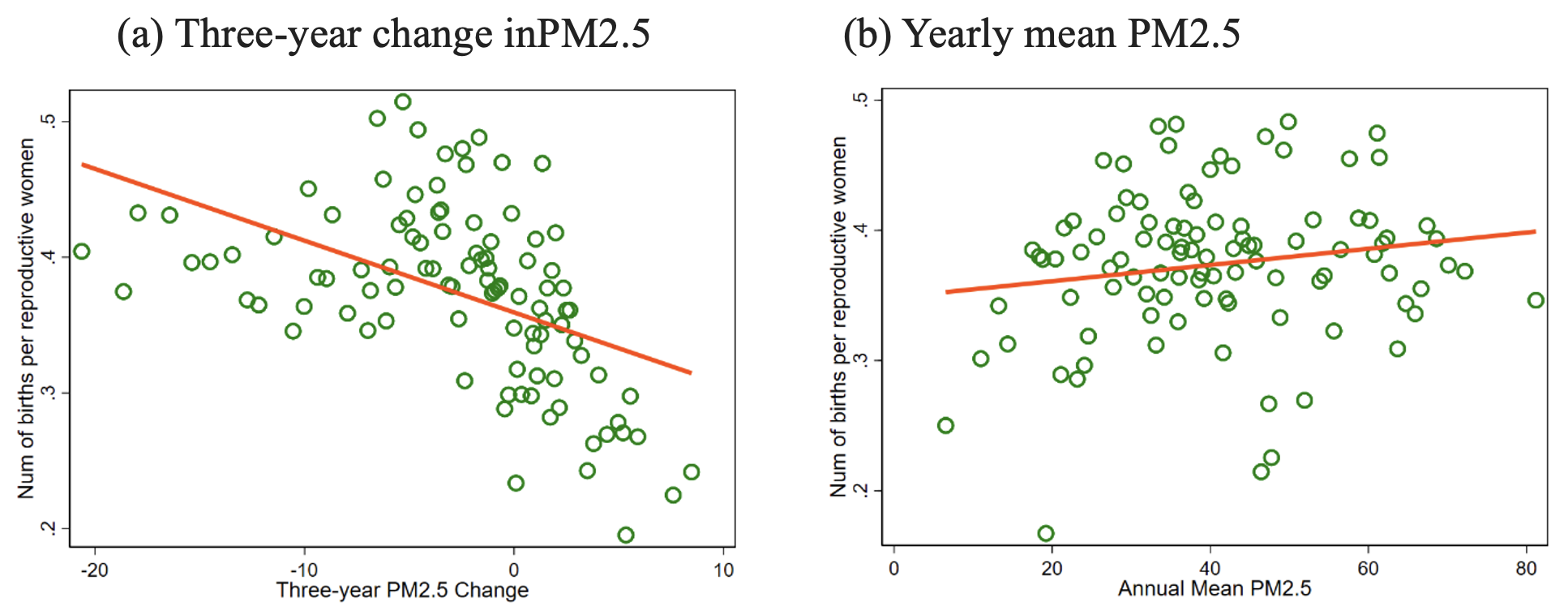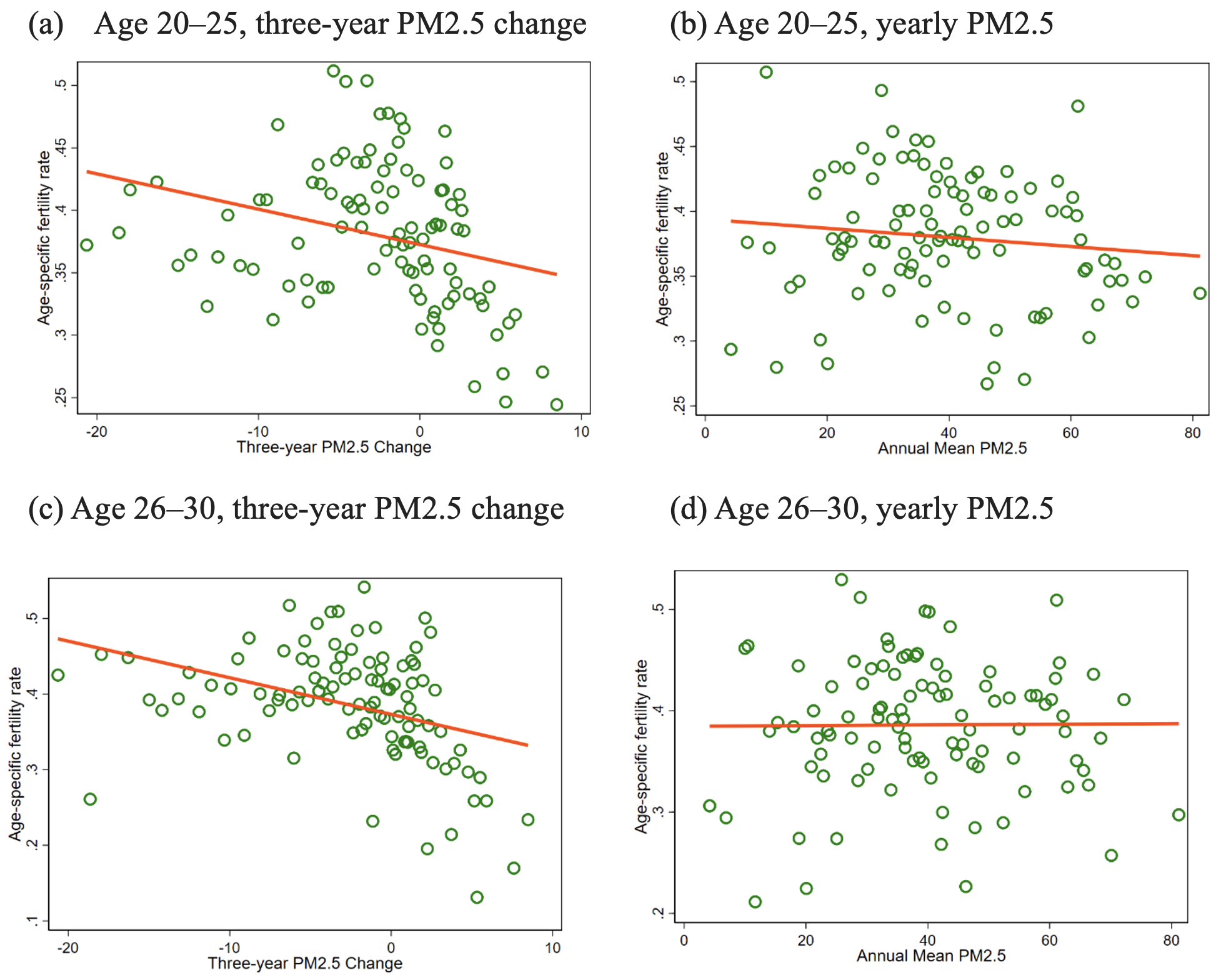There has been a long-standing debate on why fertility declines with economic growth (Galor 2000, Chatterjee and Vogl 2018). Increased pollution and declined fertility have been two defining features in countries that are experiencing rapid industrialisation, and those two widespread issues may be interlinked.
It is well known that atmospheric contamination has detrimental effects on health outcomes and the human-capital development of children. Air pollution is likely to change the parental expenditure on children’s health and education inputs, altering the shadow price of child quantity (i.e. the marginal costs associated with a new child) and consequently affecting fertility decisions. But little is known about how pollution distorts fertility behaviour.
In a recent paper (Gao et al. 2022), we use China as a laboratory to evaluate how air pollution alters the fertility decisions of reproductive-age women as well as their perceived ideal number of children.
We embed air pollution into Becker’s quantity-quality (Q-Q) model of human fertility (Becker and Lewis 1973, Becker and Tomes 1976). In our framework, the shadow price of a new child depends on the costs of investment in child quality (e.g. education expenditures, health expenditures). Under severe air pollution, parents with a strong demand for child quality are likely to increase their expenditures on their child’s educational achievement and health status to mitigate the adverse effects of pollution. However, pollution may not have a meaningful effect on those expenditures if parents’ child-quality demand is not as strong. Thus, the overall effect of pollution on the shadow price of child number, and consequently the fertility choices of individuals, depends on parental preference for child quality.
In China, the level of air pollution is hazardous, but the amount by which pollution has increased over the years varies greatly across cities (Figure 1).
This allows us to look at behavioural responses to both the temporal change and the contemporaneous level of pollution. In addition, China’s one-child policy differentially affects two groups of people. Since 1979, the one-child policy has restricted the number of children for Han people (i.e. limiting them to have only one or two children in most cases), which has increased the demand for child quality amongst this group. However, ethnic minorities in China have not been restricted by the policy, and we therefore may not see the same relationship between pollution and fertility for the group under the Q-Q model.
Figure 1 Change in city-level PM2.5 over time
Notes: Temporal distribution of PM2.5 using the Global Annual PM2.5 Grids. The figure shows the increase in PM2.5 over time for the 100 largest cities in China, relative to the 1998 PM2.5 value (the difference with respect to 1998). The red line is the unweighted average.
Figure 2 uses city-level data to relate the number of new births per reproductive-age woman with the annual mean of PM2.5 concentration as well as the three-year change in PM2.5. The number of births is negatively associated with the change in PM2.5 over time (Figure 2a), whereas the relationship between fertility outcomes and yearly mean PM2.5 is slightly positive but unclear (Figure 2b). The pattern shows that fertility decisions tend to be more responsive to the temporal change in pollution rather than the contemporaneous level of pollution.
Figure 2 Air pollution and the number of births in China
Notes: Fertility data come from National Population Census 2010. PM2.5 data are from the Global Annual PM2.5 Grids. Reproductive-age women are defined as women aged 15–50.
Figure 3 shows the association between pollution and age-specific fertility rates for the cohorts aged 20–25 and 26–30. We find similar patterns: age-specific fertility rate is negatively correlated with the three-year change in PM2.5 but does not have any detectable relationship with the short-term PM2.5 exposure, as measured by yearly PM2.5.
Figure 3 Air pollution and the age-specific fertility rate
Notes: Age-specific fertility rate is defined as the number of new births per woman of a particular age. Fertility Data come from National Population Census 2010. PM2.5 data are from the Global Annual PM2.5 Grids.
The two figures jointly document a robust pattern of how changes in pollution over time affect people’s fertility choices. Nevertheless, the relationship between contemporaneous pollution and fertility is less clear.
We may worry that the simple relationship between air pollution and fertility is confounded by other factors, such as the size of the local industrial sector. To build confidence that our estimates indeed represent the causal effect of air quality on fertility, we assemble several datasets and investigate this relationship under multiple independent sources of data variation. First, we derive exogenous fluctuations in pollution from wind direction and the historical placement of distant coal-fired plants (Freeman et al. 2019). And second, we leverage a meteorological phenomenon named thermal inversions, which traps pollution and worsens air quality (Arceo et al. 2016).
We look at the fertility of ethnic Han people, who comprise approximately 92% of the Chinese population. Our results demonstrate a meaningful impact of pollution on fertility. Individuals’ fertility decisions are more responsive to the change in pollution over time in comparison with short-term exposure to pollution. If the PM2.5 concentration increases by 10 µg/m3 over three years, the probability of having a newborn child (within 12 months) will decline by 12 percentage points.
Having shown that pollution distorts actual fertility choices, we next explore its effects on individuals’ reported reproduction preferences. We find a similar pattern to the results of fertility outcomes – a temporal increase in the exposure to pollution significantly lowers the desired number of children, whereas contemporaneous exposure to pollution does not systematically affect people’s desired number of children.
We next turn our attention to ethnic minorities, who are not constrained by China’s one-child policy. Our results reveal no significant relationship between pollution and fertility for the minority group. Since the one-child policy has had long-lasting effects on Han people’s preferences for child quantity and quality, the Han people and the ethnic minorities now show a heterogeneous fertility response to pollution.
In July 2021, China removed its birth-control policy. But the removal of the one-child policy did not meaningfully increase the fertility of the Han people. Moreover, exposure to the one-child policy’s fertility restrictions has led to higher educational attainments for both men and women and a higher labour-market participation rate for women (Huang et al. 2016, 2021). Four decades of the one-child policy have raised the Han people’s demand for their own children’s quality and lowered their preferred number of children, which can explain why the fertility choices of Han people are responsive to pollution.
A large literature has already documented that pollution leads to economic losses by threatening health and lowering productivity (Aguilar-Gomez et al. 2022, Khanna et al. 2021, Adhvaryu et al. 2019). We document how increased pollution lowers fertility. In China, declining fertility has led to a shrinking labour supply, hurting the economy and creating an increasingly serious ageing issue. In Europe, fertility is also falling and the population is similarly ageing, raising labour costs and creating fiscal burdens. Our analysis proposes a new indirect channel by which pollution adversely affects economic development and sheds light on the additional economic benefits of environmental policies.
As pollution is an inevitable by-product of production, increased pollution during industrialisation may negatively affect people’s incentives to reproduce. Thus, environmental degradation may play an important role in explaining declined fertility during economic growth.
References
Adhvaryu, A, Sadish D, N Kala and A Nyshadham (2019), “Something in the air: Managing shocks to worker productivity”, VoxEU.org, 29 September.
Aguilar-Gomez, S, H Dwyer, J Graff Zivin and M Neidell (2022), “Damage from air pollutants you won’t hear about from your doctor”, VoxEU.org, 30 June.
Arceo, E, R Hanna and P Oliva (2016), “Does the effect of pollution on infant mortality differ between developing and developed countries? Evidence from Mexico City”, Economic Journal 126(591): 257–80.
Becker, G S, and H G Lewis (1973), “On the interaction between the quantity and quality of children”, Journal of Political Economy 81(2, Part 2): S279–S288.
Becker, G S, and N Tomes (1976), “Child endowments and the quantity and quality of children”, Journal of Political Economy 84(4, Part 2): S143–S162.
Chatterjee, S, and T Vogl (2018), “Escaping Malthus: Economic growth and fertility change in the developing world”, American Economic Review 108(6): 1440–67.
Freeman, R, W Liang, R Song and C Timmins (2019), “Willingness to pay for clean air in China”, Journal of Environmental Economics and Management 94: 188–216.
Galor, O, and D N Weil (2000), “Population, technology, and growth: From Malthusian stagnation to the demographic transition and beyond”, American Economic Review 90(4): 806–28.
Huang, W, X Lei and A Sun (2016), “When fewer means more: Impact of one-child policy on education of girls”, working paper.
Huang, W, X Lei and A Sun (2021), “Fertility restrictions and life cycle outcomes: Evidence from the one-child policy in China”, Review of Economics and Statistics 103(4): 694–710.
Khanna, G, W Liang, A M Mobarak and R Song (2021), “The productivity consequences of pollution-induced migration in China”, NBER Working Paper w28401.
Khanna, G, W Liang, A Mushfiq Mobarak and R Song (2021), “The productivity consequences of pollution-induced migration in China”, VoxEU.org, 8 April.









